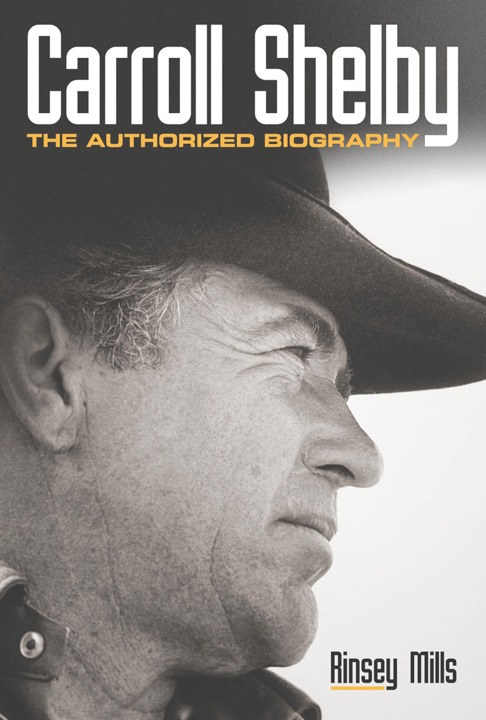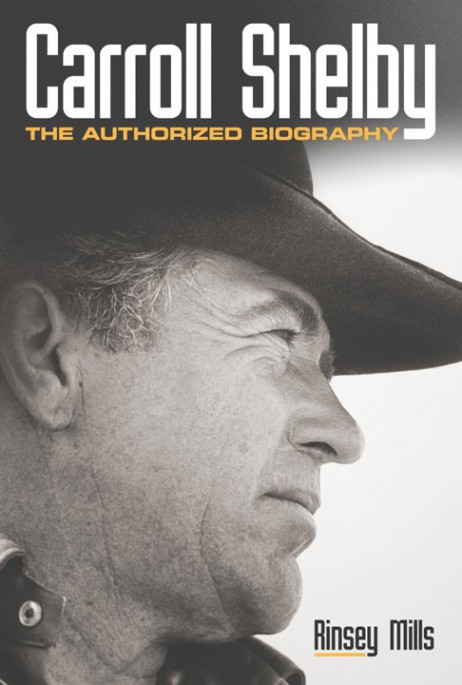I was genuinely excited to receive an advance copy of Carroll Shelby: The Authorized Biography by Rinsey Mills. The realm of very good automotive related biographies has swelled over the years with books like Erik Arneson’s Mickey Thompson book and others of the ilk. My expectation for this piece was along those lines. Carroll Shelby is nearly 90 years old now and has lived an extraordinary life. Considering that this book is over 500 pages, I assumed that it would be an open, rollicking look back at his high profile successes, failures, and fast paced life. Over the last month or so, we have heard that Shelby’s health has been in decline, so the timing of this biography could not be better to learn about this man who had such a profound effect on high performance cars in both America and across the world.
Unfortunately, it let me me down in several key aspects. The book has a very academic feel for what the subject matter is. We’re talking about the jet-setting life of a Texan turned international star, business magante, womanizer, schemer, practical joker, party animal, and the personification of what one thinks about when images of the romantic racing era of the 1950s and 1960s are conjured up. Yes, the book has vignettes and stories from the time, but there is so much minute detail heaped on to every single race report it makes sections of the book a slog. Anyone who is familiar with BangShift is well away of my love/obsession with racing history. I soak this stuff up, but even I found many details and tangents unnecessary. Mills seems obsessed with telling us how the start and first lap of every race Shelby or one of his cars competed in went. For whatever reason the reader is told time and time again how one make or car or another took an early lead and was then passed by someone else. It happens without fail perhaps dozens of times in the book.
On the human side, I was also hoping for more from the book. Although Mills does not shy away from talking with some of Shelby’s ex-wives and mentions the fact that there were “dalliances” on the road, it all seems too distant. The tales are told by the ex-wives with very little input from Shelby himself. I was not wanting to revel in the fact that the man had several failed marriages and untold “short term” relationships on the road, but frankly, that stuff makes for good reading. Anyone who has ever read Smokey Yunick’s autobiography can attest to that. The book would have been disingenuous had it not included these parts of Shelby’s life, but I wish that the relationships would have been spoken about by both sides, not just the jilted ex-wives. Shelby’s own voice would have added an important dimension to these parts of the book.
Of the nearly 550 pages, it takes 460+ of them to get to 1967. While it certainly makes that the majority of the book would be dedicated to this time in Shelby’s life because this is where he rose to international stardom as a racing driver and went on to develop the Shelby Cobra, groomed his relationship with Ford, and made piles of money both through Ford and with his Goodyear tire distributorship. The last 90 pages of the book suffer from some of the issues as the first 460. When Shelby stepped away from racing in 1970 at the close of his deal with Ford, he went into business with some associates to open a big game hunting ranch in central Africa. While there are a couple of interesting stories in the almost 20 pages dedicated to this ultimately failed venture, it added nothing, in my opinion to the book. To give you an idea how far off the path this section veers, the histories of several central African countries are told for reasons I am still confused about. Paling around with oppressive dictators to keep rich guys coming in to kill elephants and stuff, while interesting, doesn’t seem to merit a 20 page section of the book where Shelby’s short-lived association with Toyota got six paragraphs and his association with Lotus and turbine powered Indy cars got a measly eight graphs. I would assume that lots of people, like me, will be interested in reading this book to learn far more about stuff like his Toyota deal and the Indy stuff, which is never really spoken about, than a hunting venture in Africa. Maybe I am wrong on that, who knows.
The 15 pages spent on the Shelby Series 1 debacle is good reading, although in the end we are left with the feeling that Shelby is an old man who was taken advantage of by slick talking business associates. He walked down all of the wrong paths and broke all of the rules he had followed himself over the course of his 40 years in the automotive realm. I’m not sure if I wanted him to stand up, stick his chin out and say that the car was a disaster or point the finger in other directions, but instead the tone taken at the end of that section of the book was far more passive. It ends with lawyers bailing Shelby’s company out of a bad business deal made with an associate on the Series 1 project.
The book does shine in a few areas, most totally in the 1966 and 1967 GT40 efforts put forth by Shelby and Ford (along with Holman and Moody, Kar Kraft, etc). This is where the details of how Henry Ford II finally let the dogs loose and essentially demanded that the best minds in American (and European road racing a la Alan Mann) get their shit together and bring the thunder to Ferrari. With a virtually open check book, the guys from both sides of the ocean did just that, with great leadership from a handful of Ford executives. It was interested to read about Shelby’s relationship with Holman Moody and his fear/mild-distrust of them. At the onset of their relationship he was convinced that stock car guys had no place in the road racing world, but then the end of ’67 when their combined efforts had achieved the goal of smashing Ferrari’s stranglehold on Le Mans, all was well for the most part. It would be very difficult to top Mills’s efforts to completely document the Le Mans effort that Ford put forth. On this, I have to heartily commend the author for his diligence and research.
Despite the near crushing level of detail documenting Shelby’s own racing career, anyone who reads the book will come away with a far larger appreciation for just how good he was. This was not a guy who dipped his toe into the whole racing thing and built some cars, Carroll Shelby was a world class driver on the level of Moss and Fangio in his era. He was a factory driver for Aston Martin and drove nearly every exotic high end piece of iron made in the 1950s and early 1960s. From Maseratis to Allards he was there and winning in them.
Finally, it is interesting to see how being a world wide road racer formed Shelby’s skills at pitching and selling big ideas. He never had a lot of money, so his career was dependent on being bankrolled by rich guys who owned these exotic race cars and would foot the bill for a guy like Shelby to race them. He was able to glide from rich guy to rich guy until he was famous and skilled enough to become a works driver and/or race for large sponsored teams. It would be those same skills that would allow him to create the Shelby and convince both Ford and AC that the project would be a major success.
The bottom line is that if you want the most academic account of Shelby’s racing life that has ever been written and realistically will ever be written, this is the book for you. If you want the crazy stories and wild life experiences of an American icon that make for a real page turning book, you are going to be left wanting a lot more than you will get. Rinsey Mills researched this book to a very high level and he needs to be commended for that. I just wish he had captured more of Shelby’s crazy life than race results and lap times. It reads a lot like a 1970s BBC documentary put to the page.

























Did they mention his heart transplant at all??? And why he had to retire from driving?
I just finished Rinsey’s book about one of my all time heros. While the story chronicles his most interesting life in spotty detail, to really stay with it requires at least a solid foundation of the racing culture of the times.
Most of all, I found the book to be the absolutely MOST POORLY WRITTEN BOOK I’VE EVER READ! The spelling, grammar, punctuation, sentence structure and organization has set a new low standard. I’m not ordinarily too picky, but this one is positively inexcusable shocking. It’s quite obvious that no one took the time to edit the book before it went to press. Despite this, the story’s good and worth reading. It’s just too bad that Caroll chose Mr. Mills to tell his story.